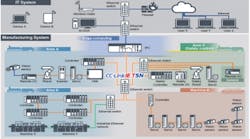By Thomas Burke, global strategic advisor at the CC-Link Partner Association (CLPA)
Advanced-automation systems from roboticized manufacturing lines, AGVs, smart machines and integrated logistics are increasingly helping to create smart factories. These data-driven, responsive facilities can greatly enhance the competitive edge of a business. However, to realize this vision, an effective way of carrying the data and control signals is required to create an autonomous, interconnected, responsive and flexible factory.
Thus, the real protagonists are industrial networks. Let’s take a closer look at how the right industrial network can jumpstart the way to a smart factory.
Connectivity—critical communications for digital transformation
Connectivity is the key word when talking about digital transformation. In fact, communication is the backbone of all the industrial components used to realize the Industrial Internet of Things (IIoT), as it brings together different entities on the factory floor, e.g., hardware devices, software tools and people, as well as higher enterprise-level systems. Connectivity enables them to collect, communicate and analyze data. By doing so, the industrial machines and the entire enterprise become intelligent systems, able to improve plant performance, productivity and flexibility.
Within this framework, a suitable network technology can go a long way toward boosting the capabilities of a factory, as it enables direct communication between manufacturing and management systems, resulting in the ability to control and make adaptive decisions based on real-time information. This is an essential prerequisite to achieving manufacturing-on-demand for a range of increasingly user-customizable products.
The foundations of a network for the future
As a large volume of devices should be seamlessly interconnected in the factory of the future, keeping the costs down while ensuring good connectivity is essential. Currently, the most attractive physical layer available is Ethernet. Compared to traditional Fieldbus, this network technology is economical and faster. Therefore, industrial Ethernet provides a better price/performance ratio. In addition, industrial Ethernet offers the possibility to create different plant topologies and is generally easier to configure and scale, which are crucial considerations when defining an enterprise’s automation strategy.
Not every kind of industrial Ethernet is sufficient, though. In order to establish an IIoT-enabled manufacturing line, large amounts of data from multiple devices need to be collected and transferred in real-time. Therefore, having enough network-bandwidth capacity is critical to the successful operation of these systems. More precisely, full-gigabit networks are becoming the standard for industrial automation.
In addition, the networking solution should be able to address different standards, as factories tend to adopt field devices and machines from different manufacturers to satisfy their production needs. As a result, open networks are key, as they provide the only solution to accommodate products from multiple vendors.
To address this aspect, it is best to use a network specification with increased openness, interconnectivity and compatibility with other solutions. For example, one that allows CC-Link IE and PROFINET to communicate with one another and allows individual devices to be connected to either network. Also, it could be beneficial to use a companion specification for machine technology and OPC UA that can enable further communication options.
Time-sensitive networking
Today, it is safe to assume that, in many cases, the network of the future will be a 1 Gbps Ethernet-based solution in line with the latest advances in technology, such as Time-Sensitive Networking (TSN). As well as offering real-time, deterministic communications, an open-protocol structure allows collaborative future development and, hence future-proofing.
Currently, there is only one industrial network that combines gigabit Ethernet performance with TSN functionalities to meet all these requirements.
Seamless communication across all levels of automation
An open architecture is a must for networks to accept devices from a number of manufacturers. However, this is not enough for the network of the future, which should maximize its compatibility on different fronts.
Not all installations are new and compatibility with legacy systems and devices is often required in ‘real world’ applications. Plus, there is always a transition period when updating an existing plant and machinery, which can include 100Mbit only connections. Yet there is only one network specification that supports these 100Mbit devices in addition to 1Gbps equipment and is easily implemented on devices or master controllers by software alone. It is a competitive advantage for a company to be able to add compatibility to its existing products without any hardware modification. Such a compatibility feature broadens the practical options when implementing upgrades or new equipment.
Secondly, the ideal system should support the convergence of information technology (IT) and operational technology (OT). It is essential to ensure that the data generated on the plant floor is accessible across all higher-level systems, from the control, supervisory and enterprise levels. This requires seamless vertical network integration, which can be obtained by using a single protocol that can span across all levels of the enterprise.
This means that, in addition to having a large bandwidth, the industrial-communications network needs to be able to schedule different types of data traffic in a highly effective manner. In particular, time-critical control data should be prioritized to support determinism and reliability on the factory floor.
These requirements are best addressed by utilizing highly accurate traffic scheduling/prioritization capabilities. As a result, time-critical control data can be shared in a timely manner and congestions can be minimized, if not eliminated.
In addition, it is important to establish reliable communications between the field devices and the enterprise level by easily integrating with network layers such as Supervisory Control and Data Acquisition (SCADA) systems or Manufacturing-Execution Systems (MES). This enables the ability to fully monitor, manage and report plant-production processes.
A future-orientated & scalable network technology
The key design principles for digital manufacturing are real-time information-transfer capabilities as well as data transparency and availability across the enterprise for advanced analytics. To implement these functionalities, it is essential to select the right industrial network, one that can accommodate different types of traffic generated by a broad range of devices while ensuring the timely delivery of each data packet.
By providing combined openness, gigabit bandwidth and TSN capabilities in an industrial-network specification, businesses can succeed in the creation of advanced digital-manufacturing strategies that enhance productivity and competitiveness.


